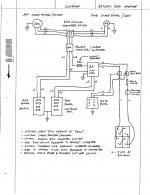RoadmasterD
Member
Hi all, 
This subject actually involves 120 Volt AC, 12 Volt DC, and Inverters/Converters all in one subject but I posted it here for lack of a better idea. Basically I'm looking for input from anyone who has performed all or some of my proposed modifications.
I've attached a scan of a diagram I created to plan my electrical system upgrade. In a nut shell, my plan is to add a 30A shore power receptacle in the left side basement area and connect it, and the factory 50A service, to a manual 60A AC selector switch followed by a 50A surge suppressor/voltage monitor. Next, one hot leg is directed to one side of the AC panel I refer to as the 50A side, and the other hot leg is routed through a 30A circuit breaker and then through a Freedom 458 2000 watt inverter/charger and back to what I refer to as the 30A side of the AC panel (down rated from 50A due to the pass through capacity limitation of the inverter).
The inverter will be powered by four T105 batteries producing about 450 Amp hours. The batteries will be installed in the front compartment in a sealed and vented box. I'm hoping to install the inverter in the factory battery compartment if there is room. Also, I plan to mount the inverter control panel, surge suppressor monitoring panel, and AC selector switch in the area where the other monitoring panels are located.
I haven't received the coach yet (one more week) so I don't know the exact configuration of the AC panel. I assume it has two independent buses. I plan to leave the factory converter installed but unplugged for emergency use if my inverter fails. Any comments or suggestions would be appreciated.
Darrin
View attachment 13063
This subject actually involves 120 Volt AC, 12 Volt DC, and Inverters/Converters all in one subject but I posted it here for lack of a better idea. Basically I'm looking for input from anyone who has performed all or some of my proposed modifications.
I've attached a scan of a diagram I created to plan my electrical system upgrade. In a nut shell, my plan is to add a 30A shore power receptacle in the left side basement area and connect it, and the factory 50A service, to a manual 60A AC selector switch followed by a 50A surge suppressor/voltage monitor. Next, one hot leg is directed to one side of the AC panel I refer to as the 50A side, and the other hot leg is routed through a 30A circuit breaker and then through a Freedom 458 2000 watt inverter/charger and back to what I refer to as the 30A side of the AC panel (down rated from 50A due to the pass through capacity limitation of the inverter).
The inverter will be powered by four T105 batteries producing about 450 Amp hours. The batteries will be installed in the front compartment in a sealed and vented box. I'm hoping to install the inverter in the factory battery compartment if there is room. Also, I plan to mount the inverter control panel, surge suppressor monitoring panel, and AC selector switch in the area where the other monitoring panels are located.
I haven't received the coach yet (one more week) so I don't know the exact configuration of the AC panel. I assume it has two independent buses. I plan to leave the factory converter installed but unplugged for emergency use if my inverter fails. Any comments or suggestions would be appreciated.
Darrin
View attachment 13063
Attachments
Last edited:

